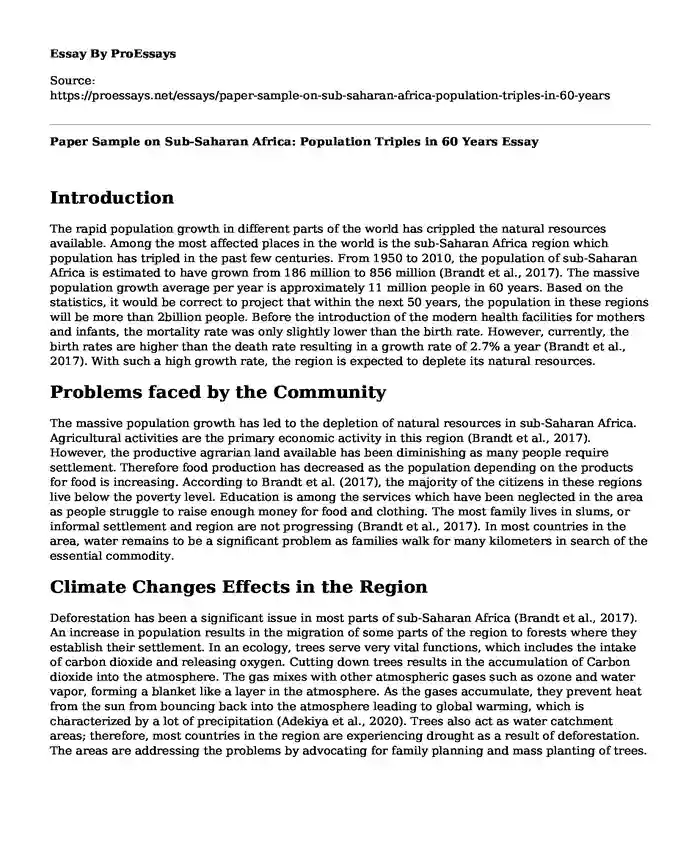Introduction
The rapid population growth in different parts of the world has crippled the natural resources available. Among the most affected places in the world is the sub-Saharan Africa region which population has tripled in the past few centuries. From 1950 to 2010, the population of sub-Saharan Africa is estimated to have grown from 186 million to 856 million (Brandt et al., 2017). The massive population growth average per year is approximately 11 million people in 60 years. Based on the statistics, it would be correct to project that within the next 50 years, the population in these regions will be more than 2billion people. Before the introduction of the modern health facilities for mothers and infants, the mortality rate was only slightly lower than the birth rate. However, currently, the birth rates are higher than the death rate resulting in a growth rate of 2.7% a year (Brandt et al., 2017). With such a high growth rate, the region is expected to deplete its natural resources.
Problems faced by the Community
The massive population growth has led to the depletion of natural resources in sub-Saharan Africa. Agricultural activities are the primary economic activity in this region (Brandt et al., 2017). However, the productive agrarian land available has been diminishing as many people require settlement. Therefore food production has decreased as the population depending on the products for food is increasing. According to Brandt et al. (2017), the majority of the citizens in these regions live below the poverty level. Education is among the services which have been neglected in the area as people struggle to raise enough money for food and clothing. The most family lives in slums, or informal settlement and region are not progressing (Brandt et al., 2017). In most countries in the area, water remains to be a significant problem as families walk for many kilometers in search of the essential commodity.
Climate Changes Effects in the Region
Deforestation has been a significant issue in most parts of sub-Saharan Africa (Brandt et al., 2017). An increase in population results in the migration of some parts of the region to forests where they establish their settlement. In an ecology, trees serve very vital functions, which includes the intake of carbon dioxide and releasing oxygen. Cutting down trees results in the accumulation of Carbon dioxide into the atmosphere. The gas mixes with other atmospheric gases such as ozone and water vapor, forming a blanket like a layer in the atmosphere. As the gases accumulate, they prevent heat from the sun from bouncing back into the atmosphere leading to global warming, which is characterized by a lot of precipitation (Adekiya et al., 2020). Trees also act as water catchment areas; therefore, most countries in the region are experiencing drought as a result of deforestation. The areas are addressing the problems by advocating for family planning and mass planting of trees.
Decisions Change on Family Due to The Climatic Problems the World is facing
The idea of starting a family and having children is a major driving force for the majority of human beings around the globe. However, the problems arising from massive population growth may result in the adoption of policies for the reduction of the growth rate by implementing family planning methods. In countries such as China, the government has set policies limiting the maximum number of children a person is supposed to get. After observing the current trends in the world economy and the depletion of natural resources, we may opt to adopt the same policies without being coerced by the government. The decisions to possibly get only one child in the future may be the best option to ensure that we can protect further damage to the environment and also have a family. Although having a family is essential, it is crucial to get children who a person can effectively raise without asserting more pressure on the ecology.
Reference
Adekiya, T. A., Aruleba, R. T., Oyinloye, B. E., Okosun, K. O., & Kappo, A. P. (2020). The effect of climate change and the snail-schistosome cycle in transmission and bio-control of schistosomiasis in sub-Saharan Africa. International Journal of Environmental Research and Public Health, 17(1), 181. https://scholar.google.com/scholar?hl=en&as_sdt=0%2C5&as_ylo=2020&q=Adekiya%2C+T.+A.%2C+Aruleba%2C+R.+T.%2C+Oyinloye%2C+B.+E.%2C+Okosun%2C+K.+O.%2C+%26+Kappo%2C+A.+P.+%282020%29.+The+effect+of+climate+change+and+the+snail-schistosome+cycle+in+transmission+and+bio-control+of+schistosomiasis+in+sub-saharan+Africa.+International+Journal+of+Environmental+Research+and+Public+Health%2C+17%281%29%2C+181
Brandt, M., Rasmussen, K., Peñuelas, J., Tian, F., Schurgers, G., Verger, A., & Fensholt, R. (2017). Human population growth offsets climate-driven increase in woody vegetation in sub-Saharan Africa. Nature Ecology & Evolution, 1(4), 1-6. https://core.ac.uk/reader/269286670.
Cite this page
Paper Sample on Sub-Saharan Africa: Population Triples in 60 Years. (2023, Sep 17). Retrieved from https://proessays.net/essays/paper-sample-on-sub-saharan-africa-population-triples-in-60-years
If you are the original author of this essay and no longer wish to have it published on the ProEssays website, please click below to request its removal:
- Trafficking For Sexual Exploitation
- The Ban on 3D Gun Blueprints Essay
- Essay Example on Investing in Canada as a US National: Gov't Policies, Culture & Inflation
- Racism in U.S.: Prevalence of Discrimination Towards People of Color - Essay Sample
- Essay on Nike's Gender Pay Gap: Lawsuit Implications & Analysis
- Victim Characteristics Linked to Bullying in Schools - Essay Sample
- Comparing Norma Jean from "Shiloh" to Winnie Mandela - Essay Sample







